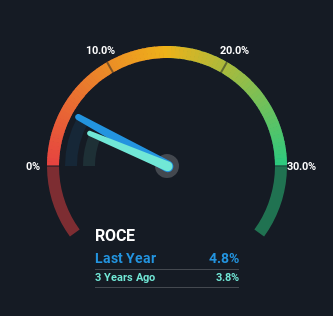Be Wary Of Geely Automobile Holdings (HKG:175) And Its Returns On Capital
Did you know there are some financial metrics that can provide clues of a potential multi-bagger? Amongst other things, we'll want to see two things; firstly, a growing return on capital employed (ROCE) and secondly, an expansion in the company's amount of capital employed. This shows us that it's a compounding machine, able to continually reinvest its earnings back into the business and generate higher returns. However, after briefly looking over the numbers, we don't think Geely Automobile Holdings (HKG:175) has the makings of a multi-bagger going forward, but let's have a look at why that may be.
Return On Capital Employed (ROCE): What Is It?
For those who don't know, ROCE is a measure of a company's yearly pre-tax profit (its return), relative to the capital employed in the business. To calculate this metric for Geely Automobile Holdings, this is the formula:
Return on Capital Employed = Earnings Before Interest and Tax (EBIT) ÷ (Total Assets - Current Liabilities)
0.048 = CN¥5.3b ÷ (CN¥216b - CN¥105b) (Based on the trailing twelve months to September 2024).
Thus, Geely Automobile Holdings has an ROCE of 4.8%. Ultimately, that's a low return and it under-performs the Auto industry average of 8.2%.
See our latest analysis for Geely Automobile Holdings

Above you can see how the current ROCE for Geely Automobile Holdings compares to its prior returns on capital, but there's only so much you can tell from the past. If you're interested, you can view the analysts predictions in our free analyst report for Geely Automobile Holdings .
How Are Returns Trending?
In terms of Geely Automobile Holdings' historical ROCE movements, the trend isn't fantastic. Over the last five years, returns on capital have decreased to 4.8% from 15% five years ago. However, given capital employed and revenue have both increased it appears that the business is currently pursuing growth, at the consequence of short term returns. And if the increased capital generates additional returns, the business, and thus shareholders, will benefit in the long run.
Another thing to note, Geely Automobile Holdings has a high ratio of current liabilities to total assets of 49%. This effectively means that suppliers (or short-term creditors) are funding a large portion of the business, so just be aware that this can introduce some elements of risk. Ideally we'd like to see this reduce as that would mean fewer obligations bearing risks.
What We Can Learn From Geely Automobile Holdings' ROCE
In summary, despite lower returns in the short term, we're encouraged to see that Geely Automobile Holdings is reinvesting for growth and has higher sales as a result. However, total returns to shareholders over the last five years have been flat, which could indicate these growth trends potentially aren't accounted for yet by investors. So we think it'd be worthwhile to look further into this stock given the trends look encouraging.
If you'd like to know more about Geely Automobile Holdings, we've spotted 2 warning signs, and 1 of them doesn't sit too well with us.
While Geely Automobile Holdings may not currently earn the highest returns, we've compiled a list of companies that currently earn more than 25% return on equity. Check out this free list here.
New: Manage All Your Stock Portfolios in One Place
We've created the ultimate portfolio companion for stock investors, and it's free.
• Connect an unlimited number of Portfolios and see your total in one currency
• Be alerted to new Warning Signs or Risks via email or mobile
• Track the Fair Value of your stocks
Have feedback on this article? Concerned about the content? Get in touch with us directly. Alternatively, email editorial-team (at) simplywallst.com.
This article by Simply Wall St is general in nature. We provide commentary based on historical data and analyst forecasts only using an unbiased methodology and our articles are not intended to be financial advice. It does not constitute a recommendation to buy or sell any stock, and does not take account of your objectives, or your financial situation. We aim to bring you long-term focused analysis driven by fundamental data. Note that our analysis may not factor in the latest price-sensitive company announcements or qualitative material. Simply Wall St has no position in any stocks mentioned.
About SEHK:175
Geely Automobile Holdings
An investment holding company, operates as an automobile manufacturer primarily in the People’s Republic of China.
Undervalued with adequate balance sheet.
Similar Companies
Market Insights
Community Narratives



